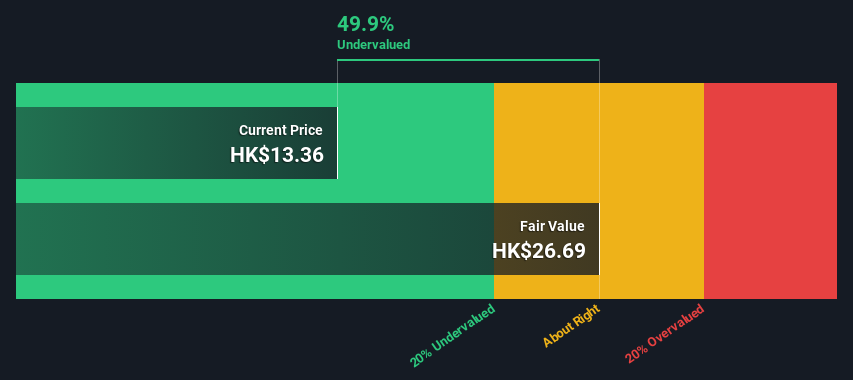- Hong Kong
- /
- Marine and Shipping
- /
- SEHK:1919
Is There An Opportunity With COSCO SHIPPING Holdings Co., Ltd.'s (HKG:1919) 50% Undervaluation?

Key Insights
- Using the 2 Stage Free Cash Flow to Equity, COSCO SHIPPING Holdings fair value estimate is HK$26.69
- Current share price of HK$13.36 suggests COSCO SHIPPING Holdings is potentially 50% undervalued
- Our fair value estimate is 89% higher than COSCO SHIPPING Holdings' analyst price target of CN¥14.16
How far off is COSCO SHIPPING Holdings Co., Ltd. (HKG:1919) from its intrinsic value? Using the most recent financial data, we'll take a look at whether the stock is fairly priced by projecting its future cash flows and then discounting them to today's value. We will take advantage of the Discounted Cash Flow (DCF) model for this purpose. Don't get put off by the jargon, the math behind it is actually quite straightforward.
We generally believe that a company's value is the present value of all of the cash it will generate in the future. However, a DCF is just one valuation metric among many, and it is not without flaws. If you still have some burning questions about this type of valuation, take a look at the Simply Wall St analysis model.
View our latest analysis for COSCO SHIPPING Holdings
Is COSCO SHIPPING Holdings Fairly Valued?
We are going to use a two-stage DCF model, which, as the name states, takes into account two stages of growth. The first stage is generally a higher growth period which levels off heading towards the terminal value, captured in the second 'steady growth' period. In the first stage we need to estimate the cash flows to the business over the next ten years. Where possible we use analyst estimates, but when these aren't available we extrapolate the previous free cash flow (FCF) from the last estimate or reported value. We assume companies with shrinking free cash flow will slow their rate of shrinkage, and that companies with growing free cash flow will see their growth rate slow, over this period. We do this to reflect that growth tends to slow more in the early years than it does in later years.
A DCF is all about the idea that a dollar in the future is less valuable than a dollar today, so we need to discount the sum of these future cash flows to arrive at a present value estimate:
10-year free cash flow (FCF) estimate
| 2024 | 2025 | 2026 | 2027 | 2028 | 2029 | 2030 | 2031 | 2032 | 2033 | |
| Levered FCF (CN¥, Millions) | CN¥75.0b | CN¥59.8b | CN¥40.0b | CN¥30.0b | CN¥25.0b | CN¥22.2b | CN¥20.6b | CN¥19.7b | CN¥19.3b | CN¥19.1b |
| Growth Rate Estimate Source | Analyst x1 | Analyst x1 | Analyst x1 | Est @ -24.89% | Est @ -16.78% | Est @ -11.10% | Est @ -7.12% | Est @ -4.34% | Est @ -2.39% | Est @ -1.03% |
| Present Value (CN¥, Millions) Discounted @ 8.1% | CN¥69.4k | CN¥51.2k | CN¥31.7k | CN¥22.0k | CN¥16.9k | CN¥13.9k | CN¥12.0k | CN¥10.6k | CN¥9.6k | CN¥8.8k |
("Est" = FCF growth rate estimated by Simply Wall St)
Present Value of 10-year Cash Flow (PVCF) = CN¥246b
We now need to calculate the Terminal Value, which accounts for all the future cash flows after this ten year period. For a number of reasons a very conservative growth rate is used that cannot exceed that of a country's GDP growth. In this case we have used the 5-year average of the 10-year government bond yield (2.2%) to estimate future growth. In the same way as with the 10-year 'growth' period, we discount future cash flows to today's value, using a cost of equity of 8.1%.
Terminal Value (TV)= FCF2033 × (1 + g) ÷ (r – g) = CN¥19b× (1 + 2.2%) ÷ (8.1%– 2.2%) = CN¥328b
Present Value of Terminal Value (PVTV)= TV / (1 + r)10= CN¥328b÷ ( 1 + 8.1%)10= CN¥151b
The total value, or equity value, is then the sum of the present value of the future cash flows, which in this case is CN¥397b. In the final step we divide the equity value by the number of shares outstanding. Relative to the current share price of HK$13.4, the company appears quite undervalued at a 50% discount to where the stock price trades currently. Valuations are imprecise instruments though, rather like a telescope - move a few degrees and end up in a different galaxy. Do keep this in mind.

Important Assumptions
Now the most important inputs to a discounted cash flow are the discount rate, and of course, the actual cash flows. You don't have to agree with these inputs, I recommend redoing the calculations yourself and playing with them. The DCF also does not consider the possible cyclicality of an industry, or a company's future capital requirements, so it does not give a full picture of a company's potential performance. Given that we are looking at COSCO SHIPPING Holdings as potential shareholders, the cost of equity is used as the discount rate, rather than the cost of capital (or weighted average cost of capital, WACC) which accounts for debt. In this calculation we've used 8.1%, which is based on a levered beta of 1.056. Beta is a measure of a stock's volatility, compared to the market as a whole. We get our beta from the industry average beta of globally comparable companies, with an imposed limit between 0.8 and 2.0, which is a reasonable range for a stable business.
SWOT Analysis for COSCO SHIPPING Holdings
- Debt is not viewed as a risk.
- Dividends are covered by earnings and cash flows.
- Earnings declined over the past year.
- Dividend is low compared to the top 25% of dividend payers in the Shipping market.
- Trading below our estimate of fair value by more than 20%.
- Annual earnings are forecast to decline for the next 3 years.
Looking Ahead:
Whilst important, the DCF calculation is only one of many factors that you need to assess for a company. DCF models are not the be-all and end-all of investment valuation. Instead the best use for a DCF model is to test certain assumptions and theories to see if they would lead to the company being undervalued or overvalued. If a company grows at a different rate, or if its cost of equity or risk free rate changes sharply, the output can look very different. Can we work out why the company is trading at a discount to intrinsic value? For COSCO SHIPPING Holdings, there are three fundamental elements you should further research:
- Risks: We feel that you should assess the 3 warning signs for COSCO SHIPPING Holdings (1 is significant!) we've flagged before making an investment in the company.
- Future Earnings: How does 1919's growth rate compare to its peers and the wider market? Dig deeper into the analyst consensus number for the upcoming years by interacting with our free analyst growth expectation chart.
- Other High Quality Alternatives: Do you like a good all-rounder? Explore our interactive list of high quality stocks to get an idea of what else is out there you may be missing!
PS. Simply Wall St updates its DCF calculation for every Hong Kong stock every day, so if you want to find the intrinsic value of any other stock just search here.
New: AI Stock Screener & Alerts
Our new AI Stock Screener scans the market every day to uncover opportunities.
• Dividend Powerhouses (3%+ Yield)
• Undervalued Small Caps with Insider Buying
• High growth Tech and AI Companies
Or build your own from over 50 metrics.
Have feedback on this article? Concerned about the content? Get in touch with us directly. Alternatively, email editorial-team (at) simplywallst.com.
This article by Simply Wall St is general in nature. We provide commentary based on historical data and analyst forecasts only using an unbiased methodology and our articles are not intended to be financial advice. It does not constitute a recommendation to buy or sell any stock, and does not take account of your objectives, or your financial situation. We aim to bring you long-term focused analysis driven by fundamental data. Note that our analysis may not factor in the latest price-sensitive company announcements or qualitative material. Simply Wall St has no position in any stocks mentioned.
Have feedback on this article? Concerned about the content? Get in touch with us directly. Alternatively, email editorial-team@simplywallst.com
About SEHK:1919
COSCO SHIPPING Holdings
An investment holding company, engages in the container shipping and terminal operations in the United States, Europe, the Asia Pacific, Mainland China, and internationally.
Flawless balance sheet and undervalued.
Similar Companies
Market Insights
Community Narratives




